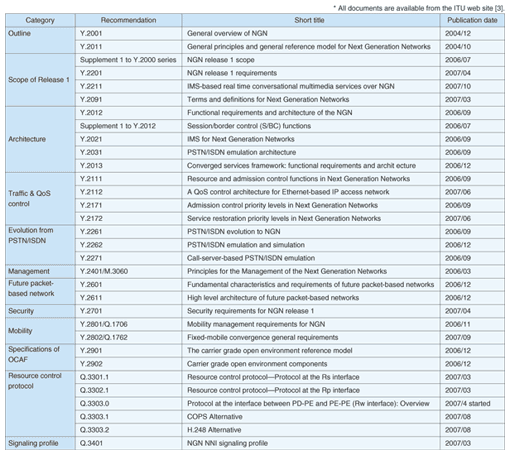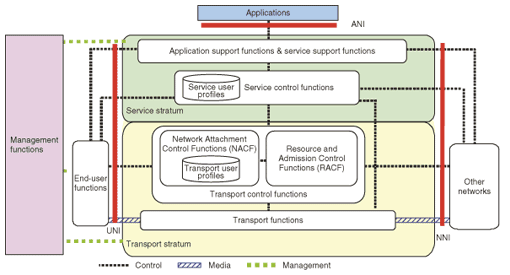 |
|||||||||
|
|
|||||||||
|
Global Standardization Activities Vol. 5, No. 11, pp. 60–63, Nov. 2007. https://doi.org/10.53829/ntr200711gls Overview and Status of NGN Standardization Activities at ITU-TAbstractInternational standardization activities toward achieving the Next Generation Network (NGN) have begun in earnest. This article outlines lively activities in the Global Standards Initiative (GSI) of the International Telecommunication Union, Telecommunication Standardization Sector (ITU-T) and in the NTT Group.
1. NGN objectivesThe NGN is an integrated network characterized by quality-control and security features to achieve safe and reliable communications. It aims to provide services equivalent to those of the traditional telephone network as well as new multimedia services for the future using packet transmission technologies such as those by leveraging Internet protocol (IP). It is receiving widespread attention as (i) a new business platform that can achieve significant cost reductions in the telecommunications infrastructure while providing fixed-mobile convergence (FMC) services and triple-play (audio, data, and video) services and (ii) a telecommunications infrastructure that can interface with a variety of information technology services [1]. 2. History of NGN studies at ITU-TInternational standardization of the NGN dates back to the NGN Workshop held by ITU-T in July 2003. This was followed by the launch in Europe of the European Telecommunication Standards Institute (ETSI), Telecoms & Internet converged Services & Protocols for Advanced Network (TISPAN) project in July 2003. This marked the beginning of studies on a next-generation telecommunications infrastructure applying the IP Multimedia Subsystem (IMS) specified by the 3rd Generation Partnership Project (3GPP) for high-speed broadband access. The first specification—NGN Release 1—was completed at the beginning of 2006 [2]. At ITU-T, NGN studies were also intensified by the formation of the Focus Group on Next Generation Networks (FGNGN) as a time-limited study system for preparing NGN standardization drafts in an efficient way by easing the restrictions on participating members and document management methods. The results from FGNGN were passed on to SG13, the lead study group for NGN studies, which initiated a Recommendations procedure in July 2006 and began issuing a sequence of formal ITU Recommendations. The FGNGN was formally terminated in December 2005, but to maintain a centralized study system, an NGN-related joint-study system called the NGN Global Standards Initiative (NGN-GSI) was formed that includes study groups such as SG11 (signaling protocols), SG19 (mobile networks), and SG17 (security issues) that hold regular meetings. 3. NGN recommendations structureThe NGN-related Recommendations issued by ITU-T are listed in Table 1 as of October 2007. The NGN standardization process adopts a release approach that issues a group of specific functions with an estimated completion date to conform to market demands. At ITU-T, the framework of NGN Release 1 can be said to be complete. The Y.2000 series of Recommendations has been given for NGN requirements and architecture. From 2007, these Recommendations have been easily accessible from the ITU web site at no charge.
4. Services envisioned by NGN Release 1Although the °»NGN Release 1 Scope°… document describes many services taking future possibilities into account, the main objective here is essentially interactive multimedia communication services (session-oriented services) based on the exchange of audio and video between two parties. Future telephone network services can be classified into PSTN/ISDN emulation services to support the transition of the communications network to the NGN without the user being aware of that transition and PSTN/ISDN simulation services that emphasize expansion to future FMC and multimedia. The coexistence of both types of services is envisioned. The NGN is expected to inherit the existing telecommunications infrastructure, and this calls for studies on services and functions that should be provided by the NGN as a public network. 5. NGN structureNetwork capabilities for achieving the services described above and the functional architecture for achieving those capabilities are being specified. An overview of the NGN is shown in Fig. 1. Conceptually speaking, the NGN consists of a service stratum and a transport stratum. The service stratum provides a variety of functions as communication services such as user authentication and registration, discovery of communication partners, and negotiation of session conditions as well as supplementary services to support and enhance those services. The transport stratum transmits IP packets on an end-to-end basis while maintaining QoS and providing security. When working in a unified fashion, these two function groups enable the provision of NGN communication services. The connection points specified between the NGN and the outside world are the User Network Interface (UNI) connecting to terminals, the Network Network Interface (NNI) connecting to other NGN operators, and the Application Network Interface (ANI) connecting to applications. The requirements for ANI are presently limited to a functional model in Recommendation Y.2012, but the plan is to take up more detailed specifications later. In the service stratum, the section for achieving basic communication services is being prescribed as service control functions. The IMS based on session initiation protocol (SIP) falls into this area. The ITU-T Recommendation reflects the views of China and other countries that place importance on complete reproduction of the existing telephone network, and it allows for call-server implementations as well as IMS-based one. The transport stratum is equipped with Network Attachment Control Functions (NACF) that perform functions such as user and terminal authentication and registration and IP-address assignment and a Resource Administrate Control Function (RACF) for determining network usage conditions and guaranteeing communication quality. The role of RACF is to accept or reject each request for establishing a session based on network availability and, if accepted, to guarantee a stable level of quality until the session completes.
6. NGN securityAnother important feature of the NGN in addition to quality guarantee is security. NGN security requirements are being specified that describe the analysis of attacks and threats against the NGN, a model for trust-based relationships as a precondition for security, and security targets and requirements. Present studies include mechanisms for achieving these requirements, authentication and approval schemes, and methods of managing user IDs (identities) taking security into account. 7. NGN signaling systemAt ITU-T, SG11 is studying NGN signaling protocols focusing on one important interface at a time while referencing the IMS specified at 3GPP and TISPAN and the detailed internal structure of the NGN. As of October 2007, Q.3401 as the NNI signaling system specifying the SIP-based connection method between NGNs and Q.3302 as interface specifications for the RACF periphery have been completed. These Recommendations reflect many contributions from NTT proposals. The next interface to be specified with a signaling system is UNI. 8. Studies toward Release 2While NGN Release 1 focuses on session-oriented services, the central themes of Release 2 are streaming services like IPTV and mobility extensions that maintain the user°«s connection without disruption even when he or she moves between different types of access systems. A focus group for IPTV (FG-IPTV) has been established in light of the success of FGNGN. In addition to existing ITU members, FG-IPTV meetings have come to include terminal makers, home appliance makers, and broadcasters, resulting in about 200 attendees at each meeting. Detailed, focused studies are now being performed. FG-IPTV specifications are scheduled to be completed in December 2007. The plan is to transfer them to related SGs for the drafting of formal Recommendations. 9. ConclusionThis article presented a brief history of NGN standardization and outlined NGN Release 1. Intensive discussions on the portion of NGN standards requiring common international specifications are now being held at ITU-T while referencing the initial studies performed in Europe. NGN Release 1 envisions session-oriented communications and specifies a framework to that end. NGN Release 2 foresees further NGN development taking into account the provision of IPTV and mobility extensions. Capitalizing on its pioneering experiences in Japan°«s broadband environment, NTT Laboratories is committed to making significant contributions to NGN international standardization in the years to come. References
|
|||||||||









